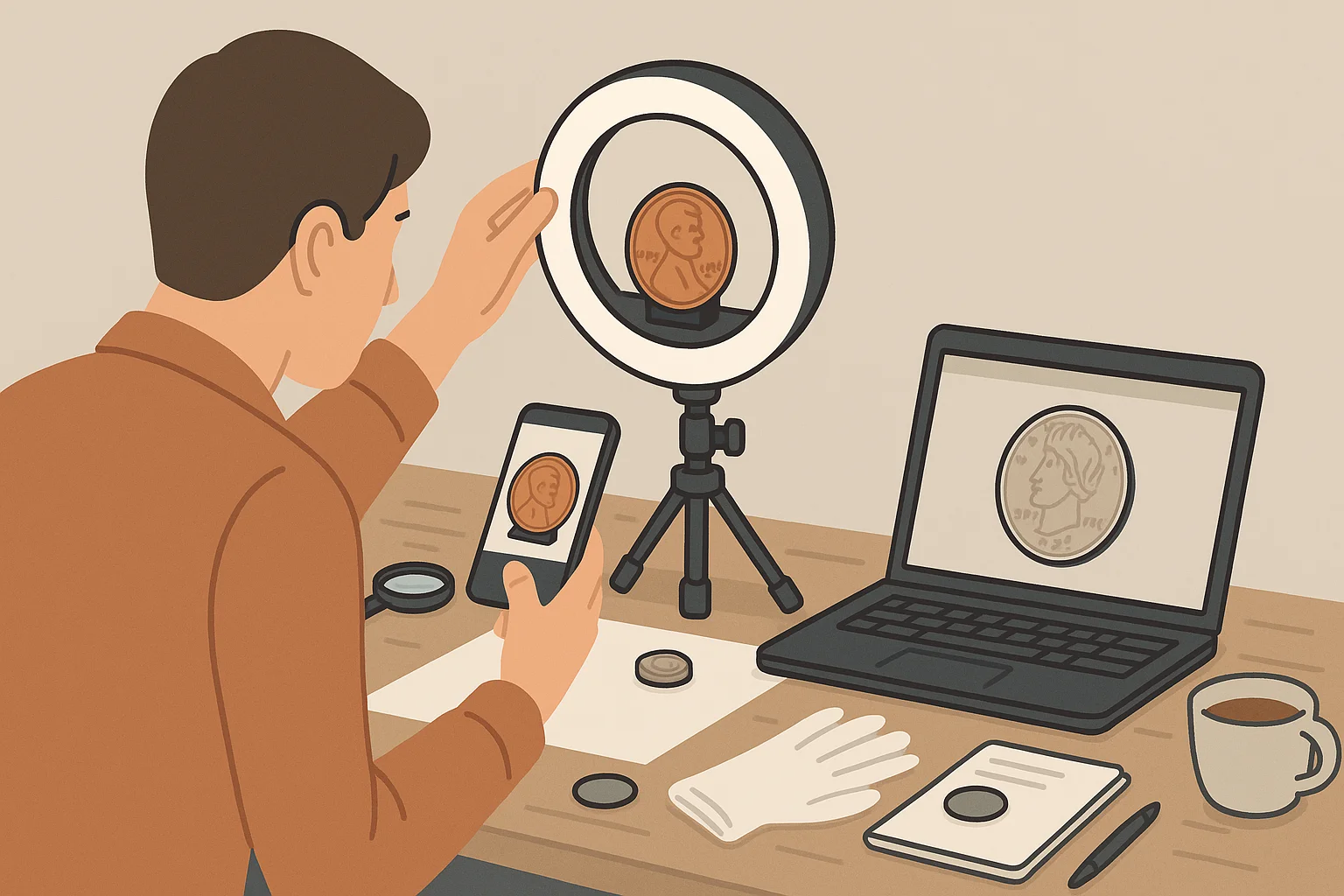Wheat pennies were minted from 1909 to 1958, and they remain among the most beloved U.S. coins ever produced. Their simple design, featuring Abraham Lincoln on the obverse and two wheat stalks framing the denomination on the reverse, has captivated generations of collectors. And sometimes understanding how much is a 1944 wheat penny worth truly strikes you — so let’s observe noteworthy varieties.

1. The 1944 Wheat Penny — A Steel Surprise
The 1944 wheat penny is legendary for its contradictions. While most were struck in copper, a small number were mistakenly minted on steel planchets left over from 1943, the year the U.S. Mint temporarily used steel to conserve copper for World War II production.
This error created one of the most valuable Lincoln cents in existence — the 1944 steel wheat penny.
Key Facts:
- Metal Composition: 99% steel with a zinc coating (accidental)
- Estimated Survivors: Fewer than 30 known
- Notable Mints: Philadelphia, Denver (D), and San Francisco (S)
Value Range:
| Grade | Typical Value | Auction Record |
| Fine (F12) | $60,000–$90,000 | – |
| Mint State (MS63) | $120,000–$200,000 | – |
| Top-Graded Example (MS66) | Up to $400,000+ | Stack’s Bowers, Heritage Auctions |
Beyond the steel error, 1944 also produced other fascinating varieties:
- 1944-D/S and 1944-S/D Mintmark Overstrikes: Created when one mint’s dies were repurposed by another, resulting in overlapping mintmarks.
- Doubled Dies and Clipped Planchets: Common small errors that still attract collectors and can sell for $50–$300depending on visibility and condition.
The 1944 steel cent is often called the “holy grail” of wheat pennies. Its accidental creation and immense value make it a dream find for both beginner and advanced collectors.
2. 1909-S VDB Wheat Penny — The First and the Famous
The debut year of the Lincoln cent series introduced both admiration and controversy. The 1909-S VDB wheat penny was designed by Victor David Brenner, whose initials “V.D.B.” appeared boldly on the reverse below the wheat stalks. Critics argued the signature was too prominent, prompting the Mint to remove it shortly after production began.
This left only 484,000 coins bearing the initials and the San Francisco “S” mint mark — a tiny mintage compared to the millions of later issues.
Key Facts:
- Mint: San Francisco (S)
- Designer: Victor David Brenner
- Distinctive Mark: “V.D.B.” on the reverse bottom edge
- Estimated Survivors: 50,000–100,000
Value Range:
| Grade | Typical Value | Prooflike Example |
| Good (G4) | $700–$1,000 | – |
| Very Fine (VF20) | $1,500–$2,500 | – |
| Mint State (MS65 RD) | $4,000–$7,000+ | $10,000+ |
This coin is often a collector’s first key date goal. Even a well-circulated specimen represents a meaningful achievement in any wheat penny collection.
3. 1914-D Wheat Penny — The Key to Mid-Series Rarity
The 1914-D wheat penny is another cornerstone of Lincoln cent collecting, ranking just behind the 1909-S VDB in rarity and demand. With only 1.193 million pieces minted, it stands out as one of the lowest mintages in the entire series.
Most 1914-D cents entered circulation, leaving few high-grade survivors. As a result, Mint State examples — particularly those with strong strikes and natural color — are exceptionally valuable.
Key Facts:
- Mint: Denver (D)
- Mintage: 1,193,000
- Known Varieties: Minor die cracks and early strikes with crisp details
Value Range:
| Grade | Typical Value | High-Grade (MS65 RD) |
| Good (G4) | $150–$200 | – |
| Very Fine (VF20) | $350–$600 | – |
| Mint State (MS65 RD) | $15,000–$30,000+ |
4. The 1922 “No D” Wheat Penny — A Minting Mystery
The 1922 No D wheat penny stands as one of the most intriguing minting errors in U.S. coinage. In 1922, only the Denver Mint produced Lincoln cents — yet, due to severe die wear and polishing, some coins were struck without a visible “D” mint mark.
This mechanical anomaly gave rise to a variety so distinct that collectors classify it as a separate issue rather than a mere error.
Key Facts:
- Mint: Denver (D) — but missing on certain dies
- Mintage: Part of 7 million coins struck in 1922
- Appearance: Lacks the “D” mint mark below the date; strong, sharp details on the obverse indicate the authentic variety
It’s important to note that many coins with a faint or partially worn “D” are not genuine No D varieties. Authentic examples show strong detail on Lincoln’s portrait but a completely absent mint mark, differentiating them from weak strikes.
Value Range:
| Grade | Typical Value | Premium Condition |
| Good (G4) | $600–$1,000 | – |
| Fine (F12) | $1,500–$2,500 | – |
| Extremely Fine (XF40) | $4,000–$6,000 | – |
| Mint State (MS63 RD) | $15,000–$25,000+ |
A verified 1922 No D cent is an essential centerpiece for any advanced wheat penny collection. Its creation through die wear rather than omission of production makes it a fascinating study in early minting technology.
5. The 1931-S Wheat Penny — The Quiet Treasure
At the height of the Great Depression, coin demand dropped dramatically as commerce slowed across the nation. The result? In 1931, the San Francisco Mint produced just 866,000 Lincoln cents — the second-lowest mintage in the entire Wheat series.
Initially overlooked, many 1931-S coins were stored by collectors who recognized their potential scarcity. Still, finding an example in pristine condition remains a challenge today, as most were saved loose rather than encapsulated.
Key Facts:
- Mint: San Francisco (S)
- Mintage: 866,000
- Design: Standard Lincoln wheat cent with fine details, no major varieties but valued for scarcity
Value Range:
| Grade | Typical Value | Exceptional Example |
| Good (G4) | $60–$100 | – |
| Very Fine (VF20) | $150–$250 | – |
| Mint State (MS65 RD) | $400–$600+ | Up to $1,200 |
Though not as dramatic as a doubled die or steel error, the 1931-S has become a staple among serious collectors because of its low mintage and historical context. It’s often the final “key date” coin needed to complete a full Wheat Penny collection.

How to Evaluate and Manage Your Wheat Pennies
As coin collecting evolves, technology has become one of the most useful companions for modern hobbyists. Instead of relying solely on traditional guides and manual comparison, collectors now use AI-powered apps and digital databases to verify coin details, estimate values, and manage growing collections efficiently.
One of the most practical tools for this purpose is the Coin ID Scanner app — a mobile solution designed for collectors who value both accuracy and convenience.
The Coin ID Scanner App: Your Digital Coin Assistant
Available on Android and iOS, the Coin ID Scanner app combines photo recognition with extensive database access to simplify coin identification and valuation. For wheat penny enthusiasts, it can quickly separate common cents from rare finds.
Key Features Include:
- Photo Identification: Snap a picture or upload an image to instantly receive the coin’s identity, including mint year, type, and denomination.
- Comprehensive Coin Data: Displays information such as metal composition, edge type, diameter, weight, mint mark, and historical background.
- Real-Time Value Estimates: Shows current collector and market prices based on grade and variety.
- Collection Management: Create a digital inventory to track, sort, and label your wheat pennies by date, mint, or condition.
- Smart Filters & AI Coin Helper: Premium users gain access to advanced search filters and an AI assistant that can flag possible mint errors or mismatched data.
With over 187,000 coins in its database, the app saves collectors hours of research and helps prevent costly mistakes — especially for those new to evaluating rare issues like the 1944 steel penny or 1922 No D.
Using Coin ID Scanner can also assist in spotting varieties before submission to grading services like PCGS or NGC, ensuring you only invest in professional certification when necessary.
Preserving the Value of Your Wheat Pennies
Even after identifying and valuing your coins, proper storage and handling are crucial. Small environmental mistakes can permanently reduce a coin’s grade and value.
Essential Preservation Tips:
- Use Acid-Free Holders: Choose archival-quality 2×2 flips or coin capsules to avoid chemical reactions that cause tarnish.
- Avoid Cleaning: Polishing or scrubbing removes natural patina and lowers resale value.
- Limit Handling: Always hold coins by the edges, never by the surface.
- Climate Control: Store collections in dry, temperature-stable environments with low humidity to prevent oxidation.
- Organize Digitally: Use your app or spreadsheet to record purchase dates, grades, and prices — keeping a complete history of your collection.
Following these practices ensures your rare wheat pennies maintain their brilliance and market potential over time.
History in Your Hands
The charm of wheat pennies lies not only in their copper sheen but in the stories they carry — from the accidental 1944 steel cent to the elusive 1909-S VDB and the mysterious 1922 No D. Each represents a piece of U.S. history, a symbol of its era’s craftsmanship and national resilience.
Numismatics rewards those who look closely — sometimes, the next six-figure penny might just be resting in the palm of your hand.





